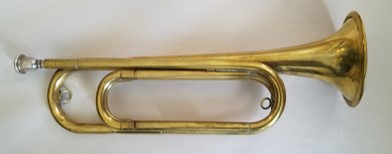American soldiers returning from World War I founded a veterans organization, the American Legion, in 1919. Reportedly impressed by British and French drum and bugle corps they had seen in Europe these war veterans began forming drum and bugle corps in the United States.
The new American Legion drum and bugle corps adopted the M1892 Field Trumpet in G as their “bugle.” This is merely conjecture, but I believe that this decision was driven by the fact that the M1894 bugle lacks a tuning slide, making it unsuitable for group performance, while the M1894 Field Trumpet can be tuned to play together in a group. I also believe that the G Field Trumpet may have been more readily available as military surplus and through commercial channels. (The Boy Scouts of America had adopted the M1892 Field Trumpet as their scout “bugle” around 1913.) Instrument manufacturers, such as Conn, were making “American Legion” bugles in both G and Bb in these early years of drum and bugle corps.

Early drum and bugle ensembles used crooks to change the key of the instrument. With G trumpets it was common to have some of the group use a D crook. So-called “two-pitch” music made use of the expanded range of notes. This practice was apparently well established by 1920. The US Army manual The Army Bugler references two-pitch music and provides information on obtaining crooks, which were not available through Army supply. This manual also mentions the use of bass bugles, pitched an octave lower, for ensemble use.
Around this time, specially manufactured bugles in D were made for use in two pitch music. While instruments pitched in G were dominant, two-pitch music performed in Bb and F was also in use. The need for two kinds of instruments, or the purchase of accessory crooks, created a budget and logistical challenge for drum and bugle corps.
Manufacturers began producing a single valved instrument so that one instrument could serve as either the G or D part. These instruments were initially intended to be a double-instrument. The valve was meant to change the key, not for melodic pitch changes while playing. The American Legion was the main rule-making body for competitions and still required all bugles to be of the military type in G. Early one valved, G-D bugles have a screw lock to fix the piston in either position. The American Legion allowed the valved bugles into competitions so long as the valves were locked so that all corps (including those with older, valveless equipment) would have similar capability. The American Legion would eventually relax this rule and allow single valved instruments to use the valve while playing, opening up the musical possibilities as corps now had access to a diatonic scale.
Corps expanded their instrumentation through the 1930s. Bass bugles evolved into baritone horns and a tenor voice was added. These instruments were available in both G-D and Bb-F configurations. Slightly later a French Horn bugle was introduced. This was also a single valve instrument but had a longer length of tubing like a French Horn which made more notes available because it used the upper end of the harmonic series.

Pingback: History of US Competition Bugles: Part 2 – The Duty Bugler
I’m enjoying your blog. I did want to make a comment about your reference to the Boy Scouts of America adopting the M1892 bugle in 1906. Lord Baden Powel established the Boy Scouts in Britain in 1908 and the Boy Scouts of America was started in 1910. My guess is that bugle was adopted later. I know I bought mine in the 1960s but I doubt if that’s relevant.
Good catch. The very first handbook in 1910 recommended to buy from a music shop. By 1913 they listed that bugles could be purchased directly from national supply.